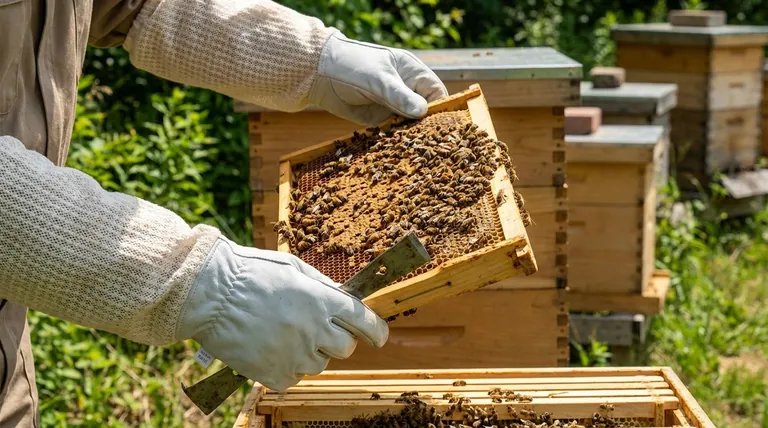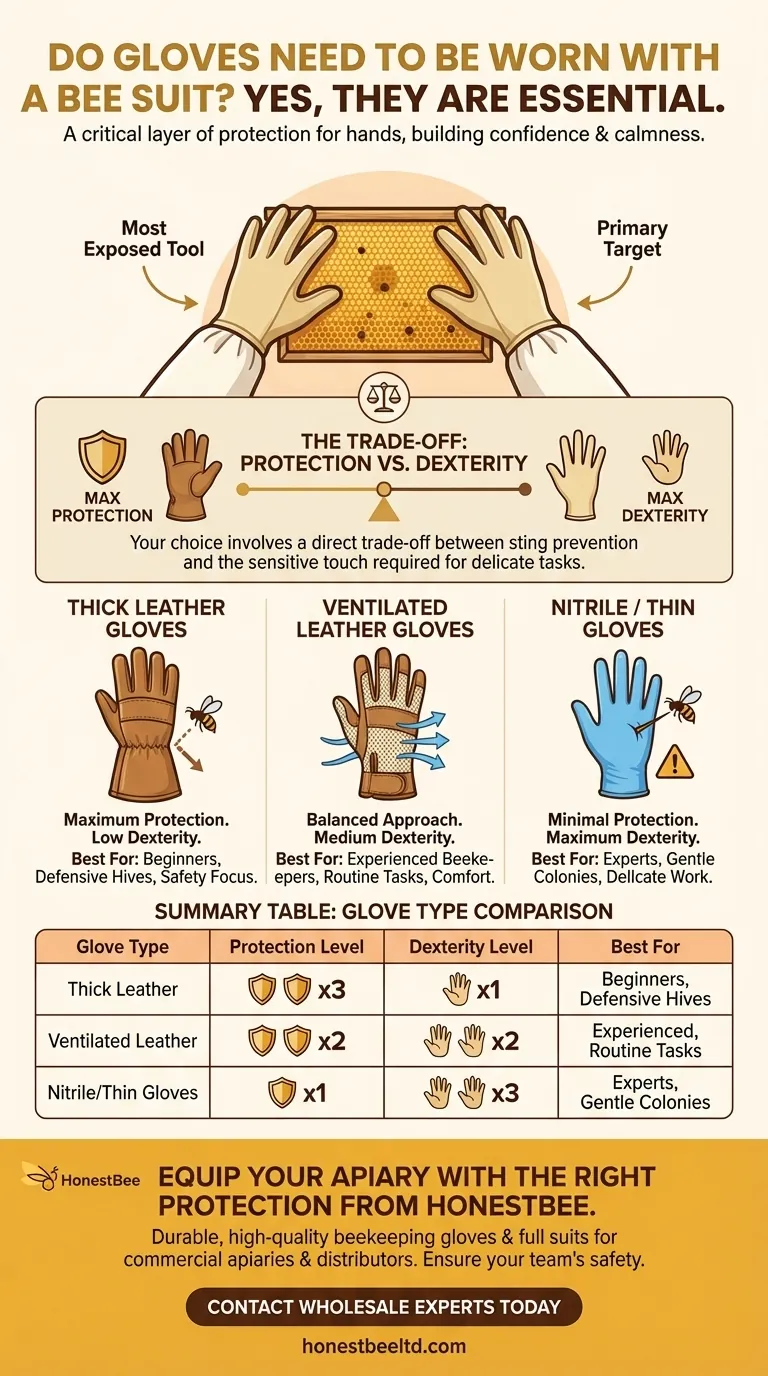Yes, gloves are a standard and essential component of a complete bee suit. While some highly experienced beekeepers may occasionally work without them, they are considered non-negotiable for beginners and a critical layer of protection for all practitioners. Your hands are the most active and exposed part of your body during a hive inspection, making them a primary target for defensive bees.
The question isn't whether to wear gloves, but rather which type of glove best suits your skill level and the task at hand. Your choice involves a direct trade-off between maximum sting protection and the dexterity required to handle frames and bees delicately.

Why Gloves Are a Core Part of Bee Protection
A bee suit is not a single garment but a system of personal protective equipment (PPE). Gloves are an integral part of that system, just as critical as the veil that protects your face.
The Purpose of a Complete System
A full beekeeping suit is designed to create a comprehensive barrier. It consists of a veil, a jacket or full coverall, and gloves, often supplemented with boot covers. Each component addresses a specific vulnerability, and leaving one out compromises the entire system.
Your Hands Are the Most Exposed Tool
During a hive inspection, your hands are in constant motion, separating frames, checking brood, and manipulating hive components. This activity can be perceived as a threat, making your hands the most likely place for a sting.
Building Confidence and Calmness
For new beekeepers, the security provided by gloves is crucial. Feeling protected allows you to move with slow, deliberate confidence. This calmness is transmitted to the bees, leading to a much more peaceful and productive inspection for both you and the colony.
Understanding the Trade-offs: Protection vs. Dexterity
Choosing the right glove means balancing the need for sting prevention with the need for a sensitive touch. There is no single "best" glove; there is only the best glove for your immediate goal.
Thick Leather Gloves: Maximum Protection
Traditional gauntlet-style gloves made of thick leather (like goatskin) offer the highest level of sting protection. A bee's stinger cannot easily penetrate the material.
The significant downside is a lack of dexterity. These bulky gloves can make it difficult to handle frames gently, increasing the risk of accidentally crushing bees, which can release alarm pheromones and agitate the colony.
Nitrile or Thinner Gloves: Maximum Dexterity
Some beekeepers opt for disposable nitrile gloves, similar to those used in medical settings. They offer an excellent feel, allowing for very delicate work.
However, they provide almost no protection from stings. They are typically used by experienced beekeepers who are highly confident in their ability to read a colony's temperament and handle bees without alarming them.
Ventilated Leather Gloves: A Balanced Approach
A popular middle ground is the ventilated leather glove. These gloves often have leather palms and fingers for reasonable protection, with a ventilated fabric back to improve airflow and flexibility. They offer a good compromise between safety and dexterity for most common tasks.
Making the Right Choice for Your Goal
Your glove choice should be a conscious decision based on your experience, the temperament of the specific hive you are working with, and the task you need to accomplish.
- If your primary focus is safety and confidence as a beginner: Start with thick, gauntlet-style leather gloves to ensure you feel secure and can focus on learning.
- If your primary focus is dexterity for delicate tasks: Consider a thinner, more flexible leather glove or a high-quality ventilated model once you are comfortable handling bees.
- If your primary focus is working with a known gentle colony: This is the only scenario where an expert might consider thinner nitrile gloves, but always have a protective pair ready.
Ultimately, proper protective gear empowers you to be a better, calmer, and more effective beekeeper.
Summary Table:
| Glove Type | Protection Level | Dexterity Level | Best For |
|---|---|---|---|
| Thick Leather | Maximum | Low | Beginners, Defensive Hives |
| Ventilated Leather | Balanced | Medium | Experienced Beekeepers, Routine Tasks |
| Nitrile/Thin Gloves | Minimal | Maximum | Experts, Known Gentle Colonies |
Equip your apiary with the right protection from HONESTBEE. We supply durable, high-quality beekeeping gloves and full protective suits designed for commercial apiaries and distributors. Ensure your team's safety and confidence during every hive inspection. Contact our wholesale experts today to discuss your equipment needs and volume pricing.
Visual Guide

Related Products
- Mesh Ventilated 3 Layer Goatskin Beekeepers Gloves for Beekeeping
- Goatskin Leather Beekeeper Gloves with Vent Long Sleeve for Beekeeping Honey Bee Sting Proof Protection
- Professional Drop-Style Hive Handles for Beekeeping
- Goat Skin Leather Bee Sting Proof Beekeeping Gloves with Canvas Sleeve
- HONESTBEE Professional Long Handled Hive Tool with Precision Cutting Blade
People Also Ask
- What factors should be considered when selecting beekeeping gloves? Balance Protection and Dexterity
- What is the role of gloves in beekeeping, especially for beginners? Build Confidence & Safety
- What should be considered when selecting beekeeping gloves? Find the Perfect Fit for Safety & Dexterity
- Why is it important to have gloves available even if not always worn? Essential Risk Management for Beekeepers
- Why do some beekeepers choose not to wear protective gear? Experience vs. Dexterity in Hive Management



















